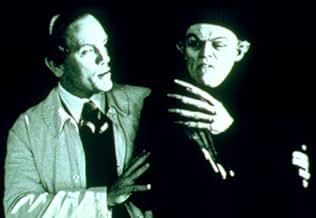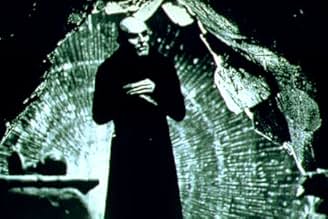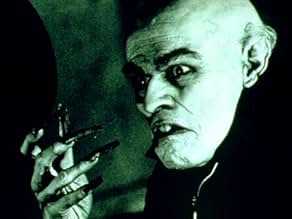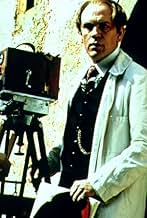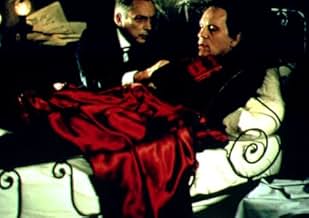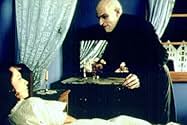The filming of Nosferatu: A Symphony of Horror (1922) is hampered by the fact that its star Max Schreck is taking the role of a vampire far more seriously than seems humanly possible.The filming of Nosferatu: A Symphony of Horror (1922) is hampered by the fact that its star Max Schreck is taking the role of a vampire far more seriously than seems humanly possible.The filming of Nosferatu: A Symphony of Horror (1922) is hampered by the fact that its star Max Schreck is taking the role of a vampire far more seriously than seems humanly possible.
- Nominated for 2 Oscars
- 16 wins & 30 nominations total
- Henrik Galeen
- (as John Aden Gillet)
- Paul - Camera Assistant
- (as Nicholas Elliot)
- Innkeeper
- (as Milos Hlavak)
- Drunken Woman
- (as Sacha Ley)
- Old Woman
- (as Marie Paule Van Roesgen)
- Director
- Writer
- All cast & crew
- Production, box office & more at IMDbPro
Storyline
Did you know
- TriviaBased in part upon a legend that Max Schreck was in reality a vampire which is why he played the role of Orlok/Dracula so well. Some variations of the legend suggest that Nosferatu: A Symphony of Horror (1922) was the only film Schreck made, though in reality he was already a stage and screen veteran by the time Nosferatu was shot, and would appear in many non-vampiric roles before his death in 1936.
- GoofsIt was utterly impossible to film at night in 1922, so all night-time scenes were actually filmed in broad daylight. Originally, these scenes were tinted blue in order to differentiate them from those that were supposed to take place by day.
- Quotes
[Asked what he thought of the book, Dracula]
Max Schreck: It made me sad.
Albin: Why sad?
Max Schreck: Because Dracula had no servants.
Albin: I think you missed the point of the book, Count Orlock.
Max Schreck: Dracula hasn't had servants in 400 years and then a man comes to his ancestral home, and he must convince him that he... that he is like the man. He has to feed him, when he himself hasn't eaten food in centuries. Can he even remember how to buy bread? How to select cheese and wine? And then he remembers the rest of it. How to prepare a meal, how to make a bed. He remembers his first glory, his armies, his retainers, and what he is reduced to. The loneliest part of the book comes... when the man accidentally sees Dracula setting his table.
- Crazy creditsCredits end with the sounds of the camera filming and of the phonograph which set the mood for the actors.
- ConnectionsEdited from Nosferatu: A Symphony of Horror (1922)
The movie asks us to imagine: What if Max Schreck, the mysterious guy who gave what is still considered one of the best vampire performances ever, did so well because, well, he really was a vampire? The skulking creature, we are to imagine, was finagled into performing in "Nosferatu" for legendary cinema pioneer F.W. Murnau. The story then follows as the crew makes the movie dealing with all sorts of difficulties, not the least of which is the star's habit of snacking on cameramen.
Among the film's many virtues is its portrayal of filmmaking in what was really its dawn as a form of art and commerce. People like me, who have trouble with silent movies may gain an additional appreciation for the work and craft that went in to them, and realize that while they may seem hokey and stylized to us now, they had a beauty and substance that was all their own, and still is.
John Malkovich turns in a great performance as the visionary Murnau (who, while tortured, must be a genius because he always gets it in one take). It is a characteristic Malkovich role, a rationalist given to bouts of fury, and it is as much fun to see him discourse pretentiously on the science and art of the moving image as it is to see him pitch a fit ("Albon, a NATIVE has wandered into my FRAME!").
The core of this movie, however, and deservedly so, is Willem Dafoe's unforgettable portrayal of Schreck. This is not your slick-talking Anne-Rice undead-Vogue kinda vampire. Schreck is the next thing up from a rat, squatting in filth and clicking his claws, and Dafoe is able to inspire laughter as well as fear, and even pathos. He makes us imagine what a rotten existence it must be, to have eternal life alone in a rotting ruin and a withered body. He and Malkovich have some great scenes together, including a sick, hilarious moment when Schreck and Murnau try to hammer out who on the crew may or may not be snacked upon (the cinematographer is necessary, it seems, but the script girl is negotiable).
The movie functions best as a sendup of moviemaking, as the harried Murnau must deal with temperamental actors, unfriendly locals, blood-sucking undead, and other hazards of the movie trade. At one point, Murnau must leave to calm the investors, a scene I really wish had been included. Some of the best moments are those of the age-old creature of the night attempting to take direction and find his "motivation." Everyone is afraid of Schreck, but admire the dedication that keeps him in character all the time (he's a Method actor, explains Murnau, he studied with Stanislavsky). The movie makes its point rather neatly, that filmmakers, and by extension filmmaking itself, have a way of sucking the life and blood out of you. Anyone who has ever had to shoot a movie on location will attest to this.
If I have a complaint about the movie, it is only that after its extreme cleverness, it settles for a somewhat straightforward horror-style denouement. Myself, I would have thought the vampire would end up moving to Berlin and getting an agent, a swimming pool, and a meeting with Ovitz. Still, the movie clearly makes its point: an auteur driven by a mania for artistic perfection can be more of a monster than something that just lives in a cave and drinks blood from your neck.
- How long is Shadow of the Vampire?Powered by Alexa
Details
- Release date
- Countries of origin
- Languages
- Also known as
- La sombra del vampiro
- Filming locations
- Vianden, Luxembourg(Castle interior scenes)
- Production companies
- See more company credits at IMDbPro
Box office
- Budget
- $8,000,000 (estimated)
- Gross US & Canada
- $8,293,784
- Opening weekend US & Canada
- $150,171
- Jan 1, 2001
- Gross worldwide
- $11,155,214
- Runtime1 hour 32 minutes
- Color
- Sound mix
- Aspect ratio
- 2.35 : 1
Contribute to this page





